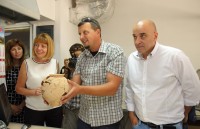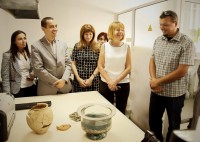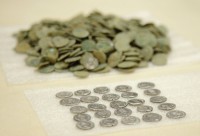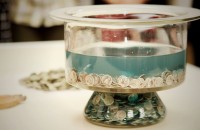Archaeologists excavating Sveta Nedelya square in Sofia, Bulgaria, have discovered a hoard of 2,976 Roman coins in a clay pot with a lid. It’s the largest Roman coin hoard ever found in Sofia, but that’s not the only exceptional thing about this find: the clay pot has a name scratched on its side. The vessel contains 2976 silver denarii from the 1st and 2nd centuries, the earliest from the reign of the Emperor Vespasian (69-79) and the latest from the reign of Emperor Commodus (177-192). There are coins bearing the faces of every Antonine emperor — Nerva, Trajan, Hadrian, Antoninus Pius — and their wives, daughters and sisters — Sabina, Faustina the Elder, Faustina the Younger, Bruttia Crispina and Lucilla.
It was hidden under the floor of an ancient public building and we know who buried it, one Selvius Callistus who had the presence of mind to scratch his name on the pot perhaps to prove ownership should it be disputed when he returned to collect his treasure. Unfortunately these tiny photographs are the only ones I could find and they don’t show the name. Usually that would be a deal-breaker for me — I discard potential stories all the time if there are no good pictures — but I’ve written about a great many coin hoard finds and this is the first one with a name carved on the vessel.
EDIT: Still no shots of the name, but here are some decently sized pictures of the find courtesy of Sofia Mayor Yordanka Fandakova’s Facebook page. Now that I can see them properly, the coins soaking in that blue solution give me the willies. They’re all scrunched together in the foot of what looks like a trifle bowl. Surely cleaning them one at a time, or at least in a tray where they aren’t rubbing against each other, would be more appropriate treatment for 2,000-year-old coins.




Founded by the Thracian Serdi tribe in the 8th century B.C., the city that would become Sofia was called Serdica. It was conquered by the Romans in 29 B.C. who renamed it Ulpia Serdica. Thanks to its location just south of the Danube frontier at the crossroads of several trade routes, the city grew to prominence within the empire. When Diocletian divided the province of Dacia Aureliana into two parts at the end of the 3rd century A.D., Serdica was awarded the status of municipium, the administrative center/capital of the new province of Dacia Mediterranea.
For a short time between 303 and 308 A.D., Serdica had its own imperial mint. The Thessalonica mint had been shut down and its employees moved to Serdica to operate the new mint. Although it was only in operation for five years, the Serdica mint was important while it lasted. Coins struck there bear the mintmark “SM” for sacra moneta (sacred money or mint) which means it was one of very few mints where gold solidi were produced. Most mints struck regular coinage marked “MP” or moneta publica.
The city prospered under Roman rule, even as the Goths and Capri devastated the former Roman province of Dacia north of the Danube (modern-day Romania) in the 3rd century. It was razed by the Huns under Atilla in 447 A.D. during his second campaign against Theodosius and the Easter Roman Empire but was rebuilt a century later by Byzantine emperor Justinian I. In 550, Justinian’s cousin Germanus was based in Serdica where he was assembling an army to wrest Italy from Gothic control. Before he could leave, he had to fight the invading Slavs. The Battle of Serdica was a great victory for the Byzantine Empire, although it only delayed the inevitable a little while.
The hoard and vessel are currently being conserved at the Bulgarian Academy of Sciences’ National Institute of Archaeology. They are expected to go on public display on September 17th at the official reopening of the Sofia History Museum in its new location, the restored Central Mineral Baths, a beautiful Vienna Secession style building constructed in the first decade of the 20th century which was a municipal bathhouse until 1986 when it fell into disrepair and was closed out of concern that the roof might collapse on bathers.